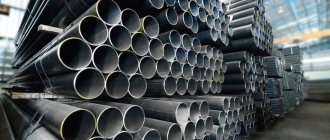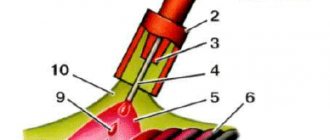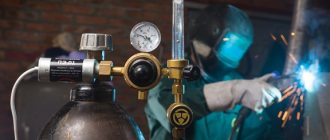Thermal conductivity and density of aluminum
The table shows the thermophysical properties of aluminum Al depending on temperature.
The properties of aluminum are given over a wide temperature range - from minus 223 to 1527 ° C (from 50 to 1800 K). As can be seen from the table, the thermal conductivity of aluminum at room temperature is about 236 W/(m deg) , which makes it possible to use this material for the manufacture of radiators and various heat sinks.
In addition to aluminum, copper also has high thermal conductivity. Which metal has the greater thermal conductivity? It is known that the thermal conductivity of aluminum at medium and high temperatures is still less than that of copper, however, when cooled to 50K, the thermal conductivity of aluminum increases significantly and reaches a value of 1350 W/(m deg). For copper, at such a low temperature, the thermal conductivity value becomes lower than for aluminum and amounts to 1250 W/(m deg).
Aluminum begins to melt at a temperature of 933.61 K (about 660 ° C), while some of its properties undergo significant changes. The values of properties such as thermal diffusivity, aluminum density and thermal conductivity are significantly reduced.
The density of aluminum is mainly determined by its temperature and depends on the state of aggregation of this metal. For example, at a temperature of 27°C, the density of aluminum is 2697 kg/m3 , and when this metal is heated to its melting point (660°C), its density becomes equal to 2368 kg/m3. The decrease in aluminum density with increasing temperature is due to its expansion when heated.
The table shows the following thermophysical properties of aluminum:
- aluminum density, g/cm 3 ;
- specific (mass) heat capacity, J/(kg deg);
- thermal diffusivity coefficient, m 2 /s;
- thermal conductivity of aluminum, W/(m deg);
- electrical resistivity, Ohm m;
- Lorentz function.
Characteristics of thermal conductivity of materials
The concept of thermal conductivity of materials is characterized by the ability to transfer thermal energy within a certain object from heated parts to cold ones. The process is carried out by atoms, molecules, electrons and occurs in any body with an uneven temperature distribution.
From the standpoint of kinetic physics, this process occurs as a result of the interaction of particles of molecules in hotter areas within the sample with other elements characterized by a lower temperature. The mechanism and rate of heat transfer depends on the state of aggregation of the substance.
The thermal conductivity category involves determining the heating rate of a material sample and the movement of a temperature wave in a certain direction. The indicator depends on physical parameters:
- density;
- temperature of phase transition to liquid state
- speed of sound propagation (for dielectrics).
Thermal conductivity of brass and bronze
The table shows the thermal conductivity values of brass, bronze, as well as copper-nickel alloys (constantan, copel, manganin, etc.) depending on temperature - in the range from 4 to 1273 K.
The thermal conductivity of brass, bronze and other copper-based alloys increases when heated. According to the table, L96 brass has the highest thermal conductivity of the alloys considered at room temperature. Its thermal conductivity at a temperature of 300 K (27°C) is 244 W/(m deg).
Also copper alloys with high thermal conductivity include: brass LS59-1, tombac L96 and L90, tin tombac LTO90-1, rolled tombac RT-90. In addition, the thermal conductivity of brass is generally higher than that of bronze. It should be noted that bronzes with high thermal conductivity include: phosphorus, chromium and beryllium bronzes, as well as BrA5 bronze.
The copper alloy with the lowest thermal conductivity is manganese bronze - its thermal conductivity coefficient at a temperature of 27°C is 9.6 W/(m deg).
The thermal conductivity of copper alloys is always lower than the thermal conductivity of pure copper, all other things being equal. In addition, the thermal conductivity of copper-nickel alloys is particularly low. The most thermally conductive of them at room temperature is cupronickel MNZhMts 30-0.8-1 with a thermal conductivity of 30 W/(m deg).
Table of thermal conductivity of brass, bronze and copper-nickel alloysAlloyTemperature, KThermal conductivity, W/(m deg)Copper-nickel alloysBrassBronze
| Beryllium copper | 300 | 111 |
| Constantan of foreign production | 4…10…20…40…80…300 | 0,8…3,5…8,8…13…18…23 |
| Constantan MNMts40-1.5 | 273…473…573…673 | 21…26…31…37 |
| Kopel MNMts43-0.5 | 473…1273 | 25…58 |
| Manganin of foreign production | 4…10…40…80…150…300 | 0,5…2…7…13…16…22 |
| Manganin MNMts 3-12 | 273…573 | 22…36 |
| Cupronickel MNZHMts 30-0.8-1 | 300 | 30 |
| Nickel silver | 300…400…500…600…700 | 23…31…39…45…49 |
| Automatic brass UNS C36000 | 300 | 115 |
| L62 | 300…600…900 | 110…160…200 |
| L68 deformed brass | 80…150…300…900 | 71…84…110…120 |
| L80 semi-tompak | 300…600…900 | 110…120…140 |
| L90 | 273…373…473…573…673…773…873 | 114…126…142…157…175…188…203 |
| L96 tombak drawn | 300…400…500…600…700…800 | 244…245…246…250…255…260 |
| LAN59-3-2 aluminum-nickel brass | 300…600…900 | 84…120…150 |
| LMC58-2 manganese brass | 300…600…900 | 70…100…120 |
| LO62-1 tin | 300 | 99 |
| LO70-1 tin | 300…600 | 92…140 |
| LS59-1 annealed brass | 4…10…20…40…80…300 | 3,4…10…19…34…54…120 |
| LS59-1V leaded brass | 300…600…900 | 110…140…180 |
| LTO90-1 tombak tin | 300…400…500…600…700…800…900 | 124…141…157…174…194…209…222 |
| BrA5 | 300…400…500…600…700…800…900 | 105…114…124…133…141…148…153 |
| BrA7 | 300…400…500…600…700…800…900 | 97…105…114…122…129…135…141 |
| BrAZhMC10-3-1.5 | 300…600…800 | 59…77…84 |
| BrAZHN10-4-4 | 300…400…500 | 75…87…97 |
| BrAZHN11-6-6 | 300…400…500…600…700…800 | 64…71…77…82…87…94 |
| BrB2, annealed at 573K | 4…10…20…40…80 | 2,3…5…11…21…37 |
| BrKd | 293 | 340 |
| BrKMTs3-1 | 300…400…500…600…700 | 42…50…55…54…54 |
| BrMC-5 | 300…400…500…600…700 | 94…103…112…122…127 |
| BrMTsS8-20 | 300…400…500…600…700…800…900 | 32…37…43…46…49…51…53 |
| BrO10 | 300…400…500 | 48…52…56 |
| BrOS10-10 | 300…400…600…800 | 45…51…61…67 |
| BrOS5-25 | 300…400…500…600…700…800…900 | 58…64…71…77…80…83…85 |
| BrOF10-1 | 300…400…500…600…700…800…900 | 34…38…43…46…49…51…52 |
| BrOTs10-2 | 300…400…500…600…700…800…900 | 55…56…63…68…72…75…77 |
| BrOTs4-3 | 300…400…500…600…700…800…900 | 84…93…101…108…114…120…124 |
| BrOTs6-6-3 | 300…400…500…600…700…800…900 | 64…71…77…82…87…91…93 |
| BrOTs8-4 | 300…400…500…600…700…800…900 | 68…77…83…88…93…96…100 |
| Aluminum bronze | 300 | 56 |
| Aged beryllium bronze | 20…80…150…300 | 18…65…110…170 |
| Manganese bronze | 300 | 9,6 |
| Production leaded bronze | 300 | 26 |
| Phosphor bronze 10% | 300 | 50 |
| Phosphor bronze annealed | 20…80…150…300 | 6…20…77…190 |
| Chromium bronze UNS C18200 | 300 | 171 |
Metal characteristics
The melting temperature of brass, depending on its composition, ranges from 880-950°C. Thus, with an increase in zinc impurity in the material under consideration, the melting point will decrease. It is worth noting that brass, due to its properties, can be welded well.
Brass is processed by resistance welding and can be rolled. The uncoated surfaces of the metal in question turn black when in contact with air. Brass has a yellow color and is highly polished. The non-ferrous metal in question can be melted within certain temperature limits, depending on the impurities in the composition of the material.
Metal Specifications
- Melting point – 880-950°C;
- Material density – 8,300-8,700 kg/cubic meter;
- Specific heat capacity - 0.377 kJ kg−1 K−1 at 20°C;
- Electrical resistivity - (0.07-0.08)·10−6 Ohm·m.
It is useful to know that bismuth, as well as lead, have a detrimental effect on brass, since they reduce the ability to deform when hot.
What are the advantages of non-ferrous metal, grade and application?
Brass belongs to the category of non-ferrous metals. It is useful to know about the chemical and physical benefits that brass has.
Advantages
- Corrosion resistance;
- High degree of fluidity;
- Excellent anti-friction properties;
- Slight tendency to segregation;
- Excellent technological properties;
- Excellent mechanical properties.
The list presented above does not limit the advantages and beneficial properties of this metal. You should not ignore the most popular brands of material, as well as application.
Melting point of brass
The melting point of brass of the considered brands varies in the range from 865 to 1055 °C. The most fusible is manganese brass LMts58-2 with a melting point of 865°C. Low-melting brasses also include: L59, L62, LAN59-3-2, LKS65-1.5-3 and others.
L96 brass has the highest melting point (1055°C). Among the refractory brasses, according to the table, we can also distinguish: brass L90, LA85-0.5, tin tombac LTO90-1.
Melting point of brassBrass, °СBrass, °С
| L59 | 885 | LMts55-3-1 | 930 |
| L62 | 898 | LMts58-2 manganese brass | 865 |
| L63 | 900 | LMtsA57-3-1 | 920 |
| L66 | 905 | LMtsZh52-4-1 | 940 |
| L68 deformed brass | 909 | LMtsOS58-2-2-2 | 900 |
| L70 | 915 | LMtsS58-2-2 | 900 |
| L75 | 980 | LN56-3 | 890 |
| L80 semi-tompak | 965 | LN65-5 | 960 |
| L85 | 990 | LO59-1 | 885 |
| L90 | 1025 | LO60-1 | 885 |
| L96 tombak drawn | 1055 | LO62-1 tin | 885 |
| LA67-2.5 | 995 | LO65-1-2 | 920 |
| LA77-2 | 930 | LO70-1 tin | 890 |
| LA85-0.5 | 1020 | LO74-3 | 885 |
| LAZ60-1-1 | 904 | LO90-1 | 995 |
| LAZHMts66-6-3-2 | 899 | LS59-1 | 900 |
| LAN59-3-2 aluminum-nickel brass | 892 | LS59-1V leaded brass | 900 |
| LANKMts75-2-2.5-0.5-0.5 | 940 | LS60-1 | 900 |
| LZhMts59-1-1 | 885 | LS63-3 | 885 |
| LK80-3 | 900 | LS64-2 | 910 |
| LKS65-1.5-3 | 870 | LS74-3 | 965 |
| LKS80-3-3 | 900 | LTO90-1 tombak tin | 1015 |
Melting point of bronze
The melting point of bronze ranges from 854 to 1135°C. Bronze AZHN11-6-6 has the highest melting point - it melts at a temperature of 1408 K (1135°C). The melting point of this bronze is even higher than the melting point of copper, which is 1084.6°C.
Bronzes with a low melting point include: BrOTs8-4, BrB2, BrMTsS8-20, BrSN60-2.5 and the like.
Melting temperature of bronze Bronzet, °С Bronzet, °С
| BrA5 | 1056 | BrOS8-12 | 940 |
| BrA7 | 1040 | BrOSN10-2-3 | 1000 |
| BrA10 | 1040 | BrOF10-1 | 934 |
| BrAZH9-4 | 1040 | BrOF4-0.25 | 1060 |
| BrAZhMC10-3-1.5 | 1045 | BrOTs10-2 | 1015 |
| BrAZHN10-4-4 | 1084 | BrOTs4-3 | 1045 |
| BrAZHN11-6-6 | 1135 | BrOTs6-6-3 | 967 |
| BrAZhS7-1.5-1.5 | 1020 | BrOTs8-4 | 854 |
| BrAMTS9-2 | 1060 | BrOTsS3.5-6-5 | 980 |
| BrB2 | 864 | BrOTsS4-4-17 | 920 |
| BrB2.5 | 930 | BrOTsS4-4-2.5 | 887 |
| BrKMTs3-1 | 970 | BrOTsS5-5-5 | 955 |
| BrKN1-3 | 1050 | BrOTsS8-4-3 | 1015 |
| BrKS3-4 | 1020 | BrOTsS3-12-5 | 1000 |
| BrKTs4-4 | 1000 | BrOTsSN3-7-5-1 | 990 |
| BrMG0.3 | 1076 | BrS30 | 975 |
| BrMC5 | 1007 | BrSN60-2.5 | 885 |
| BrMTsS8-20 | 885 | BrSUN7-2 | 950 |
| BrO10 | 1020 | BrХ0.5 | 1073 |
| BrOS10-10 | 925 | BrTsr0.4 | 965 |
| BrOS10-5 | 980 | Cadmium | 1040 |
| BrOS12-7 | 930 | Silver | 1082 |
| BrOS5-25 | 899 | HOT alloy | 1075 |
Note: The melting and boiling points of other common metals are given in this table.
Thermal conductivity of non-ferrous metals and technical alloys
The table shows the thermal conductivity values of metals (non-ferrous), as well as the chemical composition of metals and technical alloys in the temperature range from 0 to 600°C.
Non-ferrous metals and alloys: nickel Ni, monel, nichrome; nickel alloys (according to GOST 492-58): cupronickel NM81, NM70, constantan NMMts 58.5-1.54, copel NM 56.5, monel NMZhMts and K-monel, alumel, chromel, manganin NMMts 85-12, invar; magnesium alloys (according to GOST 2856-68), electron, platinum-rhodium; soft solders (according to GOST 1499-70): pure tin, lead, POS-90, POS-40, POS-30, Rose alloy, Wood alloy.
The table shows that magnesium alloys and nickel have high thermal conductivity (at room temperature). Low thermal conductivity is characteristic of nichrome, invar and Wood's alloy.
Thermal conductivity coefficients of alloys
The table shows the thermal conductivity values of alloys in the temperature range from 20 to 200ºС. Alloys: aluminum bronze, bronze, phosphor bronze, invar, constantan, manganin, magnesium alloys, copper alloys, Rose alloy, Wood's alloy, nickel alloys, nickel silver, platinum-iridium, electron alloy, platinum-rhodium.
Thermal conductivity coefficient of other materials
MaterialHumidity mass fraction % W/(m•K)
| Bakelite varnish | — | 0,29 |
| Concrete with crushed stone | 8 | 1,28 |
| Plain paper | Air dry | 0,14 |
| Viniplast | — | 0,13 |
| Gravel | Air dry | 0,36 |
| Granite | — | 3,14 |
| Clay | 15-20 | 0,7-0,93 |
| Oak (along the grain) | 6-8 | 0,35-0,43 |
| Oak (across the grain) | 6-8 | 0,2-0,21 |
| Reinforced concrete | 8 | 1,55 |
| Cardboard | Air dry | 0,14-0,35 |
| Brickwork | Air dry | 0,67-0,87 |
| Leather | >> | 0,14-0,16 |
| Ice | — | 2,21 |
| Cork boards | 0,042-0,054 | |
| Freshly fallen snow | — | 0,105 |
| Snow compacted | — | 0,35 |
| The snow has begun to melt | — | 0,64 |
| Pine (along the grain) | 8 | 0,35-0,41 |
| Pine (across the grain) | 8 | 0,14-0,16 |
| Glass (ordinary) | — | 0,74 |
| Ftoroplast-3 | — | 0,058 |
| Ftoroplast-4 | — | 0,233 |
| Cinder concrete | 13 | 0,698 |
| Plaster | 6-8 | 0,791 |
Thermal conductivity coefficient of asbestos and foam concrete at different temperatures
(ρa=576kg/m3, ρп=400kg/m3,λ, W/(m•K))
| Asbestos | — | 0,15 | 0,18 | 0,195 | 0,20 |
| Foam concrete | 0,1 | 0,11 | 0,11 | 0,13 | 0,17 |
Thermal conductivity coefficient of liquid W/(m•K) at different temperatures
| Aniline | 0,19 | 0,177 | 0,167 |
| Acetone | 0,17 | 0,16 | 0,15 |
| Benzene | — | 0,138 | 0,126 |
| Water | 0,551 | 0,648 | 0,683 |
| Vaseline oil | 0,126 | 0,122 | 0,119 |
| Castor oil | 0,184 | 0,177 | 0,172 |
| Methyl alcohol | 0,214 | 0,207 | — |
| Ethanol | 0,188 | 0,177 | — |
| Toluene | 0,142 | 0,129 | 0,119 |
Specific resistance and temperature coefficient of expansion (CTE) of metal wire (at 18ºС)
The table shows the values of electrical resistivity and CTE of metal wire made of various metals and alloys. Wire material: aluminum, tungsten, iron, gold, brass, manganin, copper, nickel, constantan, nichrome, tin, platinum, lead, silver, zinc. As can be seen from the table, nichrome wire has a high electrical resistivity and is successfully used as incandescent heating coils for many household and industrial devices.
Specific heat capacity of multicomponent special alloys
The specific (mass) heat capacity of multicomponent special alloys is given in the table at temperatures from 0 to 1300ºС.
Heat capacity dimension cal/(g deg). Heat capacity of special alloys: alumel, bell metal, Wood's alloy, Invar, Lipowitz alloy, Manganin, Monel, Rose alloy, phosphorus bronze, chromel, Na-K alloy, Pb - Bi alloy, Pb - Bi - Sn, Zn - Sn - Ni - Fe - Mn.
Specific heat capacity of aluminum
The specific heat capacity of aluminum depends significantly on temperature and at room temperature is about 904 J/(kg deg) , which is significantly higher than the specific (mass) heat capacity of other common metals, such as copper and iron.
Below is a comparative table of the specific heat capacities of these metals. The heat capacity values in the table are in the temperature range from -223 to 927°C.
According to the table, it can be seen that the value of the specific heat capacity of aluminum is significantly higher than the value of this property for copper and iron , therefore this property of aluminum, such as the ability to accumulate heat well, is widely used in industry and heating engineering, making this metal irreplaceable.
Source
Density of alloys
A table of alloy density values at room temperature is presented. The following alloys are given: bronze, tin, phosphorus, duralumin, invar, constantan, brass, magnalium, manganin, monel - metal, platinum - iridium alloy, Wood's alloy, rolled and cast steel.
NOTE: Be careful! The density of the alloys in the table is indicated in powers of 10 -3. Don't forget to multiply by 1000! For example, the density of rolled steel varies from 7850 to 8000 kg/m3.
Source
Specific heat capacity of aluminum alloys and areas of application.
The specific heat capacity of aluminum is one of the main parameters that determine the use of the metal for technical purposes for the production of parts, equipment, and structures.
Physical properties of metal
Aluminum is a chemical element (atomic number 13). It belongs to the group of light metals and is a common element found in the earth's crust. Paramagnetic metal has a silvery-white color, it is very easy to machine, and it is convenient to cast products from it. The metal has high thermal and electrical conductivity. It is resistant to air due to the ability to form metal oxide films that protect the surface from the influence of the external environment.
The film is destroyed under the influence of alkaline solutions. To prevent the metal from reacting with aggressive liquids, indium, tin or gallium are added to the alloy.
The specific heat of fusion is 390 kJ/kg, and the specific heat of evaporation is 10.53 MJ/kg. The metal boils at a temperature of 2500°C. The melting gradient depends on the degree of purification of the material and is accordingly:
- for technical raw materials +658°C;
- for metal with highest class cleaning +660 °C.
Aluminum easily forms alloys, among which everyone knows compounds with copper, magnesium, and silicon. In the jewelry industry, this metal is combined with gold, which gives the composition new physical properties.
Aluminum easily forms alloys.
In nature, a chemical element forms natural compounds. It is found in minerals such as:
In some places (volcano vents) native metal can be found in small quantities.
Areas of application
The property of chemical element No. 13 to perfectly accumulate heat allows it to be widely used in industrial production and heating engineering.
Aluminum is used as a raw material to create building structures. It is lightweight, durable, stable and is an attractive raw material for the production of window structures.
The chemical element forms non-toxic oxides, which allows its use in the production of foil for the needs of the food industry. Aluminum is a raw material for creating space rockets and aircraft. Its high reflectivity determines its use in the manufacture of mirrors.
Thermal conductivity of metal and alloys
It is a known fact that at medium and high temperature gradients the thermal conductivity of aluminum is less than that of iron or copper. The thermal conductivity of aluminum determines its use for the production of radiators.
Aluminum is a heat-intensive metal.
When the metal is cooled, the thermal conductivity increases significantly compared to copper, for which the indicator becomes lower at low temperatures.
During the remelting process, the material changes its properties: its density and thermal conductivity decrease. For example, with a temperature gradient of +27°C, the density is 2697 kg/m³; when heated to the temperature of transition to the liquid state, it becomes equal to 2368 kg/m³. This fact is due to the expansion of the mass when heated. Due to the influence of temperature, the density decreases.
The specific heat capacity of aluminum is 904 J/kg at room temperature. This indicator significantly depends on the temperature gradient, and in comparison with copper and iron for this material it is significantly higher.
The thermal conductivity of alloys containing chemical element No. 13 increases with increasing temperature. Casting compositions have a lower temperature gradient. The densest compounds are those containing silicon and zinc.
Alloys containing magnesium are lightweight. Compounds containing copper are resistant to corrosion and especially durable.
The greater the weight of aluminum in the compound, the higher the thermal conductivity. The specific heat capacity of alloys increases when heated.
Similar articles
Which conducts heat better: aluminum or copper?
Today, radiators are made from a variety of materials, the most common being steel, stainless steel and aluminum.
Always have doubts about which radiator to choose for installation in your home? Obviously, this depends on personal taste, as well as on the requirements that you have set for yourself regarding the quality of the heating of the room.
Aluminum is by far the most environmentally friendly material and has a huge number of advantages.
Differences between copper and aluminum
The main concerns regarding winding material selection reflect five characteristic differences between copper and aluminum:
Table: Five characteristic differences between copper and aluminum
| Copper | ||
| Expansion coefficient per °C x 10 -6 at 20 °C | 23 | 16,6 |
| Thermal Conductivity BTU/ft/h/FFT 2/°F at 20°C | 126 | 222 |
| Electrical conductivity % at 20°C | 61 | 101 |
| Tensile strength n/mm 2 (soft) | 28-42 | 40 |
How to choose a heating radiator: expert advice
In this article we will not consider cast iron radiators, because... they are losing popularity among buyers.
Let's focus on the most popular models.
The material will tell you in detail about the advantages of aluminum and steel batteries.
Aluminum radiators are lightweight
Aluminum radiators are lighter than traditional steel or cast iron radiators, this fact makes it possible to place such a radiator on any wall in the room.
Aluminum batteries can be hung on the wall, even in situations where the thickness does not allow for deep fastening.
This significantly saves the cost of paying for construction work, since they can be hung very quickly and reliably.
Aluminum is a corrosion resistant material
Aluminum is not subject to corrosion, which makes it an ideal material for the production of radiators that are intended to be installed in areas such as bathrooms and kitchens where there is high humidity.
Aluminum conducts heat well
Aluminum heats up quickly, making it an excellent heat conductor.
Aluminum radiators have a low water content, which means that once turned on, such devices give an intense burst of heat and heat up rooms quite quickly.
By installing aluminum radiators, you can quickly achieve the required temperature in the rooms, as they have the shortest response time.
The main advantage is a significant saving in energy costs during the heating season and, as a wonderful bonus, saving money, since aluminum radiators can be turned off while you are away from the house, and when you return home, turn them on and quickly get a warm home without spending a long time waiting.
Aluminum radiators come in a wide range of designs and colors
There is a common belief that efficient heat cannot be beautiful and original. Fortunately, the days when design must give way to superior performance are over.
Aluminum radiators have a diverse range of designs and offer even the most demanding buyer a decent choice.
You can choose your own finishing color that will perfectly match the style of your home, the shape of the radiator will be one hundred percent in harmony with your home or office atmosphere.
Stainless steel
The use of steel for the production of heat exchangers allows us to obtain durable products, which are mainly used for individual heating systems in houses and cottages.
Due to the ability to control the quality of the coolant and the pressure in the system, steel appliances will be an excellent choice for autonomous heating systems.
Provided that high-quality coolant is supplied and the working fluid pressure is moderate, such devices will last more than 30 years.
Connectivity
Oxides, chlorides, sulfides or base metals that are more conductive on copper than on aluminum. This fact makes cleaning and protecting aluminum connectors more important. Some consider copper and aluminum compounds to be incompatible. Also questionable is the mating of connections between the aluminum of the transformers and the copper connection wire.
Expansion coefficient
When temperature changes, aluminum expands almost a third more than copper. This expansion, along with the ductile nature of aluminum, causes some problems for improperly installed bolted connections.
To avoid loosening of the connection, it must be spring-loaded. By using either cup washers or pressure washers, the necessary elasticity during articulation can be achieved without compressing the aluminum.
When using proper fittings, aluminum connections can be equal in quality to copper ones.
Thermal conductivity
Some argue that since the thermal conductivity of copper is higher than aluminum, this has the effect of reducing the hot spot temperature of the transformer winding.
This is only true when the copper and aluminum winding conductors are of the same size, geometry and design.
Therefore, for any power transformer of a given size, the thermal conductivity characteristics of aluminum can be very similar to copper.
Literature
- Tables of physical quantities. Handbook, ed. I. K. Kikoina, M., 1976.
- Sivukhin D.V.
General course in physics. — T. II. Thermodynamics and molecular physics. - Lifshits E. M.
Heat capacity //
under.
ed. A. M. Prokhorova Physical encyclopedia. - M.: "Soviet Encyclopedia", 1998. - T. 2.
| This is a draft article on physics. You can help the project by adding to it. |
What is wiki.moda Wiki is the main information resource on the Internet. It is open to any user. Wiki is a library that is public and multilingual.
The basis of this page is on Wikipedia. The text is licensed under CC BY-SA 3.0 Unported License.
Heat capacity of aluminum table Link to main publication
Specific heat capacity of aluminum
Specific heat capacity of aluminum.
Specific heat capacity of aluminum:
Heat capacity is the amount of heat absorbed (released) by the entire body during the process of heating (cooling) by 1 Kelvin.
Specific heat capacity is a physical quantity numerically equal to the amount of heat that must be transferred to a body weighing 1 kg in order for its temperature to change by 1 Kelvin.
Specific heat capacity is designated by the letter c and is measured in J/(kg K).
where Q is the amount of heat received by a substance when heated (or released when cooled),
m – mass of the heated (cooled) substance,
ΔT is the difference between the final and initial temperatures of the substance.
The specific heat capacity of aluminum (c) is 0.896 kJ/(kg K).
The specific heat capacity of aluminum is given at 0 °C.
It must be borne in mind that the value of the specific heat capacity of a substance is influenced by the temperature of the substance and other thermodynamic parameters (volume, pressure, etc.), as well as how these thermodynamic parameters changed (for example, at constant pressure or at constant volume).
The exact value of the specific heat capacity of metals depending on thermodynamic conditions (temperature, volume, pressure, etc.) must be looked at in reference books.
Source: Source: Bukhmirov V.V., Rakutina D.V., Solnyshkova Yu.S. Reference materials for solving problems in the course “Heat and Mass Transfer” / State Educational Institution of Higher Professional Education “Ivanovo State Energy University named after V.I. Lenin". – Ivanovo, 2009.
Note: © Photo https://www.pexels.com, https://pixabay.com
Site Map
Demand factor 17
comments powered by HyperComments
Types of Heat Transfer
- Heat transfer is the physical process of transferring thermal energy from a more heated body to a less heated one.
Everything here is quite simple, there are only three of them: thermal conductivity, convection and radiation.
Thermal conductivity
That type of heat transfer that can be characterized as the ability of bodies to conduct energy from a more heated body to a less heated one.
It's about transferring heat through contact. Admit it, have you ever warmed yourself near a radiator? If you sat close to it, then you warmed up due to thermal conductivity. Cuddling a cat who has a hot belly is also effective.
Sometimes we go a little overboard with the possibilities of this effect when we lie down on the hot sand at the beach. There is an effect, but not a very pleasant one. Well, an ice heating pad on your forehead has the opposite effect - your forehead transfers heat to the heating pad.
Convection
When we talked about thermal conductivity, we used a battery as an example. Conduction is when we get heat by touching a battery. But all the things in the room do not touch the radiator, and the room is heated. This is where convection comes in .
The fact is that cold air is heavier than hot air (cold air is simply denser). When the battery heats a certain volume of air, it immediately rises to the top, passes along the ceiling, has time to cool down and go back down to the battery, where it heats up again. Thus, the entire room is heated evenly, because increasingly hot currents replace increasingly colder ones.
Radiation
We already mentioned the beach, but we were talking only about the hot sand. But the heat from the sun is radiation . In this case, heat is transferred through waves.
If we warm ourselves by the fireplace, do we receive heat by convection or radiation?









